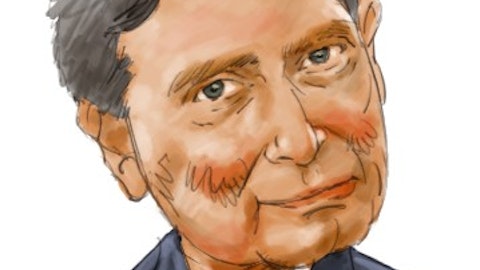Tempur Sealy International, Inc. (NYSE:TPX) Q4 2023 Earnings Call Transcript February 8, 2024
Tempur Sealy International, Inc. misses on earnings expectations. Reported EPS is $0.53 EPS, expectations were $0.54. Tempur Sealy International, Inc. isn’t one of the 30 most popular stocks among hedge funds at the end of the third quarter (see the details here).
Operator: Good day and thank you for standing by. Welcome to the Tempur Sealy Fourth Quarter 2023 Earnings Conference Call. At this time all participants are in a listen-only mode. After the speaker’s presentation, there will be a question-and-answer session. [Operator Instructions] Please be advised that today’s conference is being recorded. I would now like to hand the conference over to your speaker, Aubrey Moore, Investor Relations. Please go ahead.
Aubrey Moore: Thank you, operator. Good morning, everyone, and thank you for participating in today’s call. Joining me today are Scott Thompson, Chairman, President and CEO; and Bhaskar Rao, Executive Vice President and Chief Financial Officer. This call includes forward-looking statements that are subject to the safe harbor provisions of the Private Securities Litigation Reform Act of 1995. These forward-looking statements involve uncertainties, and actual results may differ materially due to a variety of factors that could adversely affect the company’s business. These factors are discussed in the company’s SEC filings, including its annual report on Form 10-K and quarterly reports on Form 10-Q under the headings Special Note regarding forward-looking statements and risk factors.
Any forward-looking statement speaks only as of the date on which it is made. The company undertakes no obligation to update any forward-looking statements. This morning’s commentary will include non-GAAP financial information. Reconciliations of this non-GAAP financial information can be found in the accompanying press release, which has been posted on the company’s investor website at investor.tempursealy.com and filed with the SEC. Our comments will supplement the detailed information provided in the press release. And now with that introduction, it’s my pleasure to turn the call over to Scott.
Scott Thompson: Thank you, Aubrey. Good morning, everyone, and thank you for joining us on our 2023 fourth quarter and full year earnings call. I’ll begin with some highlights from the quarter and full year, and then turn the call over to Bhaskar to review our financial performance in more detail and discuss our 2024 guidance. After that, I’ll provide an update of our proposed acquisition of Mattress Firm, before opening up the call for Q&A. In the fourth quarter of 2023, net sales were approximately $1.2 billion, and adjusted EPS was $0.53. Our results were in line with our expectation for the quarter, with sales and adjusted EPS approximately consistent with prior years. Turning to a few highlights for 2023. First, I’d like to highlight our resilience of our business model, our robust cash flow and industry-leading balance sheet.
Our solid financial position has given us flexibility to capitalize on the industry’s opportunities. We’re delivering strong operating cash flow, investing in the business and outperforming the broader bedding market in North America and internationally. In the last three years, we’ve generated over $1.0 billion in cash flow after investing $1.3 billion in advertising and over $600 million in CapEx. We believe the strategic investments in our brands, capabilities and capacity enabled us and our retailers to succeed in a dynamic environment. Versus the prior year, adjusted EBITDA to net debt leverage declined from 3.1 to 2.87. We expect to continue to reduce our leverage in the coming quarters as we prepare for the closing of the proposed Mattress for transaction.
The US bedding industry, which is our largest market, was challenged in 2023. Based on preliminary figures, we believe the category units were down double-digits versus the prior year, and the US produced mattress units were below the 20-year trough for the industry. However, we have recently seen stabilization of the category demand. The international markets we operate in have generally demonstrated similar trends on a consolidated basis. Over the prior two decades, the bedding industry has consistently grown through both ASP and unit expansion over time. We anticipate that the category will return to his historical trends of consistent growth. With our strong financial position, resilient operating model and the recent investments we’ve made in the business, Tempur Sealy is uniquely positioned to reap the benefits of an improving market.
The second item I’d like to highlight is our successful rollout of our new iconic premium products and continued expansion of extensive manufacturing capabilities. These actions in 2023, solidified our position as a leading vertically integrated global bedding company. Internationally, we successfully launched and all new lineup of timber mattresses, pillows and bed bases in over 90 markets, introducing new innovation and expanding our total addressable market globally. The consumer-centric innovation and expanded price points in the new collections for driving positive traction and broad range of customers, including our legacy ultra-premium consumers that mattress prices at 3,000 and above as well as consumer shopping for mattresses starting at 2000.
The reaction to the new products has been positive. On the cost side, we have streamlined the construction of the new product to maximize manufacturing efficiencies, enhance our ability to efficiently customize products to meet customers’ needs in diverse markets and channels. In the US, the new TEMPUR-breeze and Stearns & Foster product portfolio completed their rollout in 2023 and realized notable year-over-year growth. The TEMPUR-breeze portfolio achieved double-digit sales growth and a 5% increase in mattress and foundation ASP, while Stearns & Foster portfolio also delivered strong sales growth over the same period. These premium brands significantly outperformed the market and drove higher ASP for the entire category at a time when retailers are dealing with reduced floor traffic.
In 2024, we expect to complete the full refresh of our US Tempur portfolio by introducing our next generation of Adapt products. The new Adapt products are focused on meeting one of the highest consumer needs in mattresses, reduced aches and pains. This line includes our most advanced Tempur Material, uniquely designed to deliver 20% more pressure relief than the standard Tempur Material. The Adapt products paired with our own proven line of innovative smart adjustable bases will build on the success of prior generations and Tempur Sealy’s robust R&D track record. We have over 60,000 new Adapt mattresses ready as we prepare for the rollout to begin in the first quarter and expect to reach substantial completion before the Memorial Day holiday.
In 2023, we also opened our newest and largest state-of-the-art plant in Crawfordsville, Indiana. This new facility located in the Midwest, complements our existing manufacturing footprint, enhances our ability to serve Northeast customers. Our expanded US manufacturing footprint will allow us to capture the projected long-term demand for our products and to support our rapidly growing OEM business. The new facility has the capabilities to manufacture a wide variety of bedding products and components for branded and non-branded operations. Our third highlight is the diversification of our business model and go-to-market approach. One of our long-term initiatives is to increase the visibility with the consumer wherever and however they choose to shop.
We follow the customers’ lead and aim to provide quality products at every price point, both on and offline. In support of our broader portfolio diversification strategy, we are pursuing growth initiatives through innovation and development of industry-leading products. growing our wholesale business through existing and new retail relationships and increasing our investments in Stearns & Foster brand. We’ll also look to expand further into the OEM market and grow our direct-to-consumer business through the expansion of our e-commerce channels and company-owned stores. All these initiatives are in line with our pursuit of long-term sustainable growth. For example, our direct-to-consumer channel has increased from $150 million in 2015 to over $1.2 billion in 2023, a compound annual growth rate of 30%.
This was in part thanks to the expansion into hundreds of new company-owned stores around the world and the successful launch of our Stearns & Foster and Sealy e-commerce websites. Additionally, we began offering OEM and private label products in 2020. And today, we generate hundreds of millions of dollars in profitable private label and OEM sales with further opportunities for growth in 2024 and beyond. Lastly, our growth in wholesale has been broad-based across existing and new distribution. In fact, in April, we’ll be expanding our products into additional big-box stores with one of the largest U.S. bedding retailers. Fourth, I’d like to highlight significant expansion in our year-over-year consolidated gross margin. We delivered year-over-year improvement of 260 basis points in our consolidated gross margin to 44.2%, in the fourth quarter of 2023.

This is a result of efforts from the team to drive profitability by leveraging our fixed cost structure over multiple growth initiatives. As mentioned, our new product innovation investments in manufacturing processes and plant and diversification of our go-to-market strategy have all contributed to improved gross margin. As we continue to drive greater efficiency, we increase our ability to invest in advertising, product development and our people. We also benefit from a larger pool of free cash flow to drive EPS growth and reduce our net leverage. While we expect the retail environment to remain dynamic, we have a track record of delivering results during challenging cycles. In fact, we generated $4.9 billion in sales and $2.2 billion in gross profit for the full year 2023, both of which were just shy of our highest ever annual sales and gross profit figures.
In 2024, we plan to stay focused on our long-term initiatives stay agile to capture opportunities and deliver higher sales and profits. Our last highlight is on our commitment to protect and improve our communities and the environment, as we detailed in our recently published 2024 corporate social values report. The report is available on our IR website. We are proud of our achievements over the last year, including our zero waste to landfill status at our Canadian and Mexican manufacturing facilities and maintaining our zero waste landfill status at our U.S. and European manufacturing operations. This year, we contributed over $800,000 in shared contributions through our Tempur Sealy Foundation and donated more than 12,100 mattresses worth approximately $16.9 million, bringing our cumulative 10-year donation total to over $100 million.
With that, I’ll turn the call over to Bhaskar.
Bhaskar Rao: Thank you, Scott. In the fourth quarter of 2023, consolidated sales were approximately $1.2 billion, and adjusted earnings per share was $0.53. We have $33 million of pro forma adjustments in the quarter, all of which are consistent with the terms of our senior credit facility. These adjustments are primarily related to the cost incurred in connection with our planned acquisition of Mattress Firm. Turning to North America results. Net sales decreased 4% in the fourth quarter. On a reported basis, the wholesale channel decreased 6% and the direct channel increased 11%. The North America adjusted gross profit margin improved to 40.7%, primarily driven by favorable commodities and operational efficiencies, partially offset by unfavorable product mix.
Product mix is primarily being driven by the continued growth of our OEM initiative. North American adjusted operating margin improved to 15.9% driven by improved gross margins, partially offset by investments in growth initiatives. Now turning to International. Net sales increased 8% on a reported basis and 4% on a constant currency basis in the Fourth Quarter. As compared to the prior year, our International gross margin improved to 55.7% driven by commodities, partially offset by unfavorable mix. Our international operating margin decreased to 19.2%, driven by higher operating expense from investments in growth initiatives, partially offset by improvements in gross margins. One of our growth initiatives is expanding our retail store footprint, and we now operate over 750 stores globally.
Now, to balance sheet and cash flow items. At the end of the Fourth Quarter, consolidated debt less cash was $2.5 billion, and our leverage ratio under our credit facility was 2.87 times, within our historical target range of 2 to 3 times. In the Fourth Quarter, we generated operating cash flow of $91 million. We’re pleased to report that we have successfully entered into a $625 million delayed draw term loan and increased the availability of our existing revolver by $40 million. This is in connection with our financing plan for the anticipated acquisition of Mattress Firm in late 2024. Upon closing the acquisition, we plan to fund the cash portion of the transaction with a combination of cash on hand and through existing and incremental borrowings.
Our financing plan for this acquisition is consistent with our historic history of balancing financial flexibility, leverage and the cost of capital. We have already executed on elements of this strategy by successfully refinancing our credit facilities in 2023 and now with the new delayed draw term loan. We anticipate raising incremental borrowings closer to the closing of the transaction and expect net leverage to be between 3 and 3.25x, assuming a closing in the second half of 2024. We expect to return to our target leverage ratio range of two to three in the first 12 months after closing. Now turning to our 2024 guidance, we expect adjusted EPS to be in the range of $2.60 to $2.90. Our guidance is based on sales increasing low to mid-single digits versus 2023.
This also considers our expectation that the US bedding industry unit volumes are stable versus the prior year, which implies slight headwinds in the first half and recovery in the second half of 2024. Our sales outperforming the industry due to new distribution wins in the US and the continued success from the new product launches overseas. And advertising spend of about $500 million as we continue to support our leading brands and new products. All of this resulting in adjusted EBITDA of approximately $1 billion at the midpoint of the range. I want to note two phasing items for 2024. First, we believe the year-over-year negative unit trend seen in the US bedding industry over the past year are mitigating. We believe industry units will likely be down high single-digits through the end of 2023, and while we expect the first quarter will be down some, we believe units for the industry will return to year-over-year growth later this year.
Second, we recently opened our new Crawfordsville facility to provide us with incremental capacity to support our long-term growth. In April, we will start servicing our new distribution that Scott spoke to previously, which will mark the beginning of our growth into this capacity. The phasing between this capacity and our new volume will result in our historical seasonality being a bid off. Ass we grow into Crawfordsville, the timing of the shipping of new distribution and our near-term category outlook, we expect this to pressure profit in the first quarter, likely resulting in EPS being between $0.45 and $0.50. We expect to return to delivering year-over-year EPS growth starting in the second quarter of 2024. As we noted, we expect our full year adjusted EPS to grow 15% at the midpoint of our guidance.
Our guidance also considers the following allocations of capital in 2024. CapEx of approximately $150 million, down significantly from prior years as our major capital projects are complete. This is a more normalized level of spend driven by maintenance spend of $110 million and growth spend of approximately $40 million, and a quarterly dividend of $0.13, representing an increase of 18% relative to 2023. Lastly, I would like to flag a few modeling items. For the full year of 2024, we expect D&A of approximately $200 million to $210 million. Interest expense of approximately $135 million to $140 million on a tax rate of 25% with a diluted share count of 179 million shares. With that, I’ll turn the call back over to Scott.
Scott Thompson: Thank you, Bhaskar. Nice job. Before opening up the call for questions, let me provide a brief update on our pending acquisition of Mattress Firm. In the fourth quarter, we certified substantial completion with the FTC second request. We continue to work with the FTC to advance the transaction approval process. We anticipate these conversations will continue through the first quarter. As previously, disclosed we continue to expect the transaction to close in mid to late 2024. In connection with and contingent upon the acquisition, we are proactively pursuing a divestiture plan and engaging with Mattress Firm suppliers. In parallel, Tempur Sealy and Mattress Firm continue to make joint progress on integration planning.
Lastly, a brief comment on Mattress Firm’s financial performance. Mattress Firm recently made their quarterly results available on their website, which were consistent with our expectations. We encourage you to review Mattress Firm’s website for more information on their financial performance for the most recent quarter. In summary, our progress towards the transaction close is on track and we look forward to joining with the Mattress Firm team. And with that, I’ll open up the call for questions. Operator?
See also 20 Fastest Growing Professions in 2024 and 15 Free Dating Sites For Singles in the US.
Q&A Session
Follow Tempur Sealy International Inc. (NYSE:TPX)
Follow Tempur Sealy International Inc. (NYSE:TPX)
Operator: Certainly. [Operator Instructions] And our first question will be coming from Susan Maklari of Goldman Sachs. Your line is open.
Susan Maklari: Thank you. Good morning, everyone.
Scott Thompson: Good morning, Susan.
Susan Maklari: Good morning, Scott. Maybe to start with why don’t we talk a little bit about demand? You mentioned that it seems like we have bottomed out in the fourth quarter and that this year we could see a sequential improvement as we move through. How are you thinking about that, I guess relative to the macro backdrop the potential for rates to come down? And what else do you think is stimulating the consumer a bit perhaps to start to see some improvement on the unit side?
Scott Thompson: Well, obviously we have easier comps, which is probably the first thing that’s got to be pointed out. Second thing obviously, we are at an all-time low when we’re talking about the US in volume. So we are really at rock bottom from a historical standpoint. And as you mentioned, there are some green shoots. Obviously, we’re in an environment where interest rates are trending down. We’re also — if you look at the bedding industry and we just got back from the Vegas bedding show there’s good innovation in the industry. We’ve got some new product coming out and others have some new product coming out that’s very interesting. We’ve also seen some of our larger retailers, I’m going to say, refocus on advertising and we’ve got several of them increasing their advertising budgets going into 2024.
So, yeah, in general it feels like I’ve used the term balancing around the bottom. We’re kind of bouncing around the bottom. If you go back and look at the fourth quarter and kind of look at it parse it by month, October was not good in the US and then it got better throughout the quarter. And then you get to the January period. And obviously, it’s very difficult in this world to forecast. If we look at our own order book in January, it’s positive. If I look at our online sales in January it’s up double digits. So it looks like some green shoots, but you have to dampen that when you look at some of the details, the order book is positive, but it’s concentrated in some larger customers. It’s not as broad-based as we’d like to see. If you go talk to the retailers and listen to them, floor traffic is down double digits.
And their January — when you talk to the retailers in general are talking about being down 10%. And then you think about January it’s only 30% of the quarter. So what I’m kind of saying, it’s all mixed and we are continuing to get some mixed signals, but clearly bouncing around the bottom seems to be the best description currently.
Susan Maklari: Okay. That’s helpful color. Thank you. Good luck.
Operator: And one moment for our next question. And our next question will be coming from Peter Keith of Piper Sandler. Your line is open.
Peter Keith: Hey, thanks, good morning everyone. Maybe it’s a bit of a financial question for Bhaskar, but I was hoping you could quantify the EPS or EBITDA impact from these facility start-up costs in Q1. And then also provide a little bit of color on how you guys are thinking about input costs year-on-year and launch costs year-on-year?
Bhaskar Rao: Absolutely. So let me take those one at a time. If you think about the first quarter specifically, a couple of things happening there. We called out the phasing of revenue. We called out our expectations on a category. Also is that we have some — great news is we’re really excited about what’s happening from a Tempur Adapt. And also good news is that the Adapt is going out earlier than where the Breeze did in prior year. So that’s a couple of pennies between the first and second quarter. Specifically as it relates to the question you asked about Crawfordsville, as a whole about $30 million of D&A increase on a year-over-year basis, so when you parse that out for the quarter, think of that at about a couple of three sets.
As it relates to input costs from a full year perspective, we still remain constructive. We’ve seen some tailwinds in 2023. It’s very consistent with where we left it and coming out of the third quarter as it relates to our input cost expectations. At that point, we called out let’s call it 20, 30 points bps benefit for 2024. So that’s basically where we remain today. All that said is that, we are mindful of what’s happening in the Red Sea, but our expectations are still positive as it relates to the commodity input costs. And then closing it out with launch expenses, on a full year basis is we would expect launch cost to be flat. However, as I called out, there is some phasing that happens between 1Q and 2Q, given the timing of the Adapt is a bit earlier than where it was with Breeze in prior year.
Scott Thompson: I’ll pile on that just a little bit Bhaskar and highlight Crawfordsville. Obviously, that’s a huge investment for us. And while others in the industry are closing plants and reducing capacity, we’re adding capacity. And what you’re seeing in the first quarter is basically turning on the plant full. And so you get the fixed cost of the plant coming through the income statement, before you get the profits coming from the product, which will come in the second quarter. The good news is, we’ve got orders. We need the plant and it’s busy. We’ve just got a timing on the building of the product and when revenues show up because the cost of the products will show up in inventory, but the whole fixed cost of the plant has got to go through the income statement. So, we’re really excited about the future of that operation.
Peter Keith: Okay. Thank you, very much guys.
Operator: And one moment for our next question. Our next question will be coming from Bobby Griffin of Raymond James. Your line is open.
Bobby Griffin : Hey, good morning everybody. Thanks for taking my question. So Scott or Bhaskar I was just hoping when we look at the 2024 sales guidance flat industry units kind of as the starting point and then maybe build a little bit to your guide of call it maybe 3% to 4% at the midpoint. Can you unpack the drivers to get there? Is it mostly market share gains mix price? Just anything to help with some context around what’s assumed in the building blocks and the size of those building blocks to walk us from the industry to Tempur Sealy’s performance.
Scott Thompson : Sure. I’ll let Bhaskar do the details. But foundationally we have two big distribution wins that have been executed and those sales will show up in April. Guess you want go for it?
Bhaskar Rao : Absolutely. So just starting with the category, as we indicated is that our expectation is that it will be flat for the full year. However, as you called out as well there will be a bill. So let’s call that big round numbers down in the — down low singles in the first half and up in the back half. So when you think about the phasing of sales and with the new distribution that Scott spoke to is that it is a bill as you go from one to two and then you see the growth in three from a couple of different areas. The new products getting out there in Adapt the continuing momentum that we’re seeing in international and the improvement from a category standpoint specifically disaggregating that a little bit. We’re super excited about what we’re seeing internationally.
We would expect the growth in our international new product launch. We saw the green shoots in the third quarter. It continues to grow in the fourth quarter and we’re very excited about what that could do for us in 2024 and beyond. So the expectation is that we would see growth in international in all of the quarters. And then now bouncing back to the U.S. So what that would imply is that taking share internationally. When we get into the U.S. is our — the way that we think about this. It is really the market share gains would be tied to the new distributions wins that we have in hand. Obviously, that’s our expectation is that’s what we’ve assumed in the guide. But our expectation is always is to continue to outperform the market.
Bobby Griffin : Very good. Appreciate the details. Best of luck for executing this year.
Operator: One moment for our next question. And our next question will be coming from Jason Haas of Bank of America. Your line is open.
Jason Haas : Hey, good morning and thanks to taking my question. I’m curious if you could provide a little bit more color on the distribution gains that you cited? Was that really in reference to one big box retailer? Are you seeing some more broad distribution gain? Thanks.
Scott Thompson : We’ve got two large distribution gains in-house that the revenues will come starting in call it April, so there’s two big ones. And then like always there’s hand-to-hand combat on the smaller side, but there are two that are a little more needle moving. I guess it would be a fair way to say it.
Jason Haas : Got it. That’s helpful. Thank you.
Operator: And one moment for our next question. Our next question will be coming from Seth Basham of Wedbush. Your line is open.





